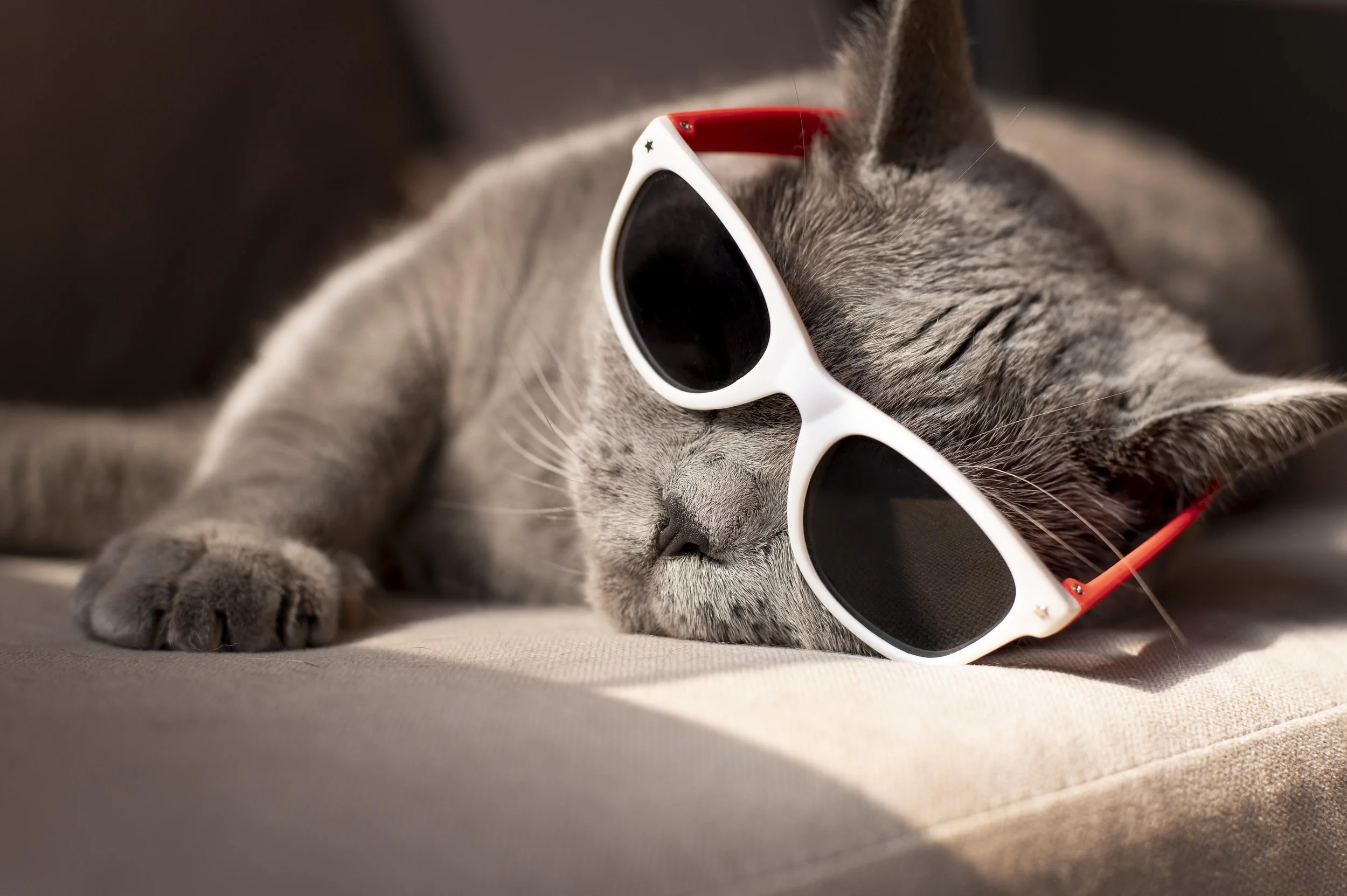Keeping Your Cat Cool in the Heat
As temperatures rise, it’s crucial to help your cat stay comfortable and safe. Cats are sensitive to heat, and overheating can quickly become dangerous. Here’s how to keep your cat cool, hydrated, and healthy during the summer months.
Create a Cool Retreat
Provide a cool, dark place: Cats naturally seek out shaded, quiet spots. Make sure they have access to a cool, dark area indoors.
Use a gentle fan: Use a small fan to create a light breeze, but always keep oscillating fans and cords out of your cat’s reach for safety.
Keep cats indoors: Especially during high heat, keep your cat inside to prevent overheating or getting trapped in spaces with poor ventilation (like garages or sheds).
Keep Them Hydrated
Multiple water bowls: Place water bowls throughout your home to encourage drinking. Change the water frequently and clean bowls daily to prevent bacteria.
Try a cat fountain: Many cats prefer running water and will drink more if it’s available.
Entice picky drinkers: Add a splash of tuna or sardine water to their bowl if your cat isn’t drinking much.
Feed wet food: Wet food contains significantly more moisture than dry food, helping to keep your cat hydrated. You can also add extra water to their wet food and/or cool it down in the fridge beforehand.
→ Quick Check for Dehydration: To test hydration, gently lift the skin along your cat’s back and let it go. If it snaps back quickly, your cat is well hydrated. If the skin stays tented, this is a sign of dehydration and requires prompt attention.
Grooming
Keep Coats Tidy
Brushing your cat regularly is especially important during the warmer months. Excess fur can trap heat, so keeping their coat free of mats and loose hair helps them stay cooler. Cleaning their paw pads and trimming any hair can also support better temperature regulation.
Watch For Overgrooming
You may notice your cat grooming more frequently in the summer. This is a natural cooling mechanism (similar to how humans sweat) and also helps with shedding, which tends to increase in hot weather. However, if your cat seems to be grooming excessively, it could be a sign of heat stress or even heatstroke. If you're concerned, it's best to seek veterinary advice.
Avoid Shaving
While it might seem like a good way to help your cat stay cool, shaving is not recommended. A cat’s fur acts as insulation against both heat and cold, and removing it can increase the risk of sunburn, skin irritation, overheating, and other health issues.
Light trimming for long-haired cats can help with shedding and comfort, without removing their natural protection.
Special Considerations for Vulnerable Cats
Senior cats: Older cats are especially sensitive to heat. Keep them indoors and away from poorly ventilated spaces.
Sun-sensitive cats: Cats with white or light-coloured fur, pink noses, hairless breeds, or those losing hair are at higher risk for sunburn and skin cancer. Use a vet-approved, cat-safe sunscreen on exposed areas like ears and noses if your cat enjoys sunbathing.
➜ If you notice scaly, sore, or crusty skin, contact your vet promptly.
Know the Signs of Heatstroke
Heatstroke in cats is a medical emergency that occurs when their body temperature exceeds 104°F. Some cats are more at risk: seniors, overweight cats, flat-faced breeds, kittens, and those with pre-existing conditions.
Watch for these subtle signs:
Panting
Distressed breathing
Drooling
Increased heart rate
Vomiting or diarrhea
Lethargy
Bright red tongue or hot ears
Unusual vocalization
If you suspect heatstroke:
Cool first, transport second: Move your cat to a cool, calm environment. Use cool (not cold) water or a damp towel to gently cool them—avoid ice or submerging your cat, as this can cause stress.
Seek immediate veterinary care: Continue gentle cooling while transporting your cat to the vet.
Quick Tips for a Safe Summer
Always prioritize hydration, shade, and ventilation.
Use only vet-approved products for sun protection and cooling.
Monitor for subtle signs of heat exhaustion or dehydration, and act quickly if they appear.
If you know of any stray cats in your area, ensure to leave them water and offer them a shady place to cool off. Ensure any cats in your neighbourhood are secured in their homes.
Consult your veterinarian for tailored advice, especially for vulnerable cats (seniors, kittens, or those with health conditions).
By following these tips, you’ll help your cat stay safe and comfortable all summer long. Always monitor your cat for signs of distress and consult your veterinarian if you have any concerns. Here’s to a happy, healthy, and cool summer!
References
Creative, Catchfire. “A Guide to Cat Grooming in the Summer.” Dr. Elsey’s, 18 July 2022, https://www.drelseys.com/2022/07/18/a-guide-to-cat-grooming-in-the-summer/.
Cross, Blue. “Blue Cross.” Blue Cross, https://www.bluecross.org.uk/advice/cat/top-tips-for-keeping-your-cat-cool-in-summer. Accessed 25 June 2025.
Fryer, DVM Jennifer S. “Heatstroke in Cats: Signs, Treatment, and Prevention.” PetMD, 8 Sept. 2023, https://www.petmd.com/cat/conditions/systemic/heatstroke-cats.
“Heatstroke in Dogs and Cats.” Prevention, Symptoms and First Aid Tips for Pet Owners, https://www.rvc.ac.uk/small-animal-vet/teaching-and-research/fact-files/heatstroke-in-dogs-and-cats. Accessed 26 June 2025.
Leeson, Janelle. “8 Ways to Keep Your Cat Cool This Summer.” Daily Paws, 19 July 2022, https://www.dailypaws.com/cats-kittens/cat-safety-tips/how-to-keep-cats-cool-in-summer.

